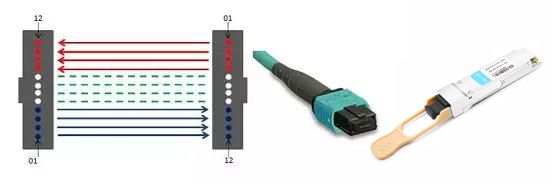

 Knowledge Base +
Knowledge Base +  2024.01.05
2024.01.05A QSFP28 transceiver typically has 4, 8, or 16 communication lanes, depending on the type and configuration.
Features of Mainstream 100G QSFP28 Optical Modules
● 100G QSFP28 SR4: The interface is identical with 40GBase-SR4, which is connected to a QSFP28 optical transceiver through an MTP / MPO fiber connector. The original MTP / MPO physical fiber link can be directly upgraded for 100G applications. Regular OM3 and OM4 MMF feature 70m and 100m transmission respectively for 100G applications.

∆ 100G QSFP28 SR4 Transmission Diagram and QSFP28 SR4 Interface
● 100G QSFP28 SWDM4: This module includes three main characteristics; first, this interface, which supports a QSFP28 optical transceiver uses a 2- 2-fiber duplex LC connector. Second, it enables 300m transmission over WBMMF and at least 100m transmission over OM4 for 100G. Last, compared with the SR4 model, the SWDM4 model demands only 25 percent of its fibers.
● 100G QSFP28 CWDM4: It also adopts QSFP28 transceivers. Unlike a traditional and high-cost transceiver for 10km over SMF, the cost of this transceiver for 2km is more competitive. However, it is not acknowledged by the IEEE organization either and is popularized by the PSM4 MSA.

∆ Transmission Principle of 100G QSFP28 CWDM4 Optical Transceiver Module
● 100G QSFP28 PSM4: This type of model transmits 100G data with its single-mode MTP/MPO optic fiber connector. Designed with built-in QSFP28 interfaces, it utilizes regular OS2 SM to realize a transmission reach up to 500m, which makes its overall price competitive. However, it is not acknowledged by the IEEE organization and is popularized by the PSM4 MSA.
Subscribe to the newsletter
for all the latest updates.
2-5# Building, Tongfuyu Industrial Zone, Aiqun Road, Shiyan Street, Baoan District, Shenzhen. China
